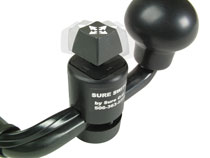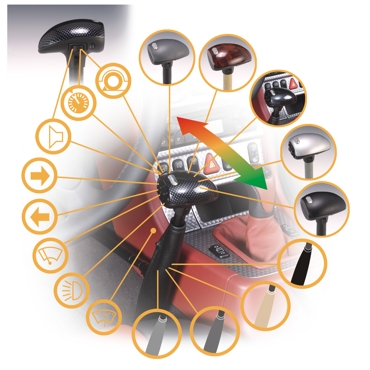Secondary Vehicle Controls for Drivers with Disabilities
What are Secondary Controls
First, primary controls are the gas, brake, and steering. A person with a disability might use hand controls to operate their car's gas and brake pedals. They might also use a spinner knob to use in turning the steering wheel. Secondary controls are all the other things that a disabled driver will need to operate in order to drive safely: horn, lights, dimmer, turn signals, wipers, and cruise control. While they are often overlooked, the ability to operate secondary controls is very important. Which controls need modification or adaptation and how the adaptations are performed will need to be determined by the individual needs of the disabled driver, the use of other adaptive equipment, and budget. If a driver doesn't use their horn, then there really is no need to go to the expense of adapting the horn. Of course there is also more than one way to skin the cat. For instance, the disabled driver can simply get into the habit of turning on their lights (and later turning them off) before each trip or before certain trips rather than go through the expense of adapting the headlights.
Why do Secondary Controls Need to be Adapted or Modified
Because one hand is going to be on the hand control operating gas/brake and the other on the steering wheel, and sometimes in a steering wheel device such as a tri-pin or v-cuff. That means your hands are going to be busy and the normal OEM operators might be difficult or impossible to reach. This is going to depend on the type of hand control used and your physical abilities. For instance if you're a paraplegic and using Sure Grip push rock style hand controls, then the hand controls should be installed such that you will have access to the smart stick control on most cars. However, if you choose a control such as the Menox hand control for right hand use, you'll find it very difficult to operate the same smart stick.
Ways to Adapt Secondary Controls
- Simple Extensions
- Through Hand Control Switches
- Standalone Audible Switch Activated Secondary Controls
Simple Extensions
This includes items such as the MPD turn signal extensions and similar type modifications that your vehicle modifier can custom make. Usually extensions are installed when the control simply needs to be extended to be closer to the driver's hand.
Hand Controls
Buttons or switches are built into or mounted on the hand controls for operating the secondary control functions. For instance on MPD hand controls it is common for the horn and dimmer functions to be operated using two push buttons built right into the hand control itself. The number of secondary control functions that each hand control can potentially operate is determined by the hand controls itself. For MPD hand controls it is 2, for Sure Grip hand controls it is up to 4+ (uses Sure Switch 4 position mini joystick, can install more than one) for Menox hand controls it can be up to 6 functions.

Sure-Switch for Operating Secondary Controls with Sure Grip hand controls

Menox hand control with multiple secondary control functions
Audible Switch Activated Secondary Controls
If required, a single switch can be used to operate your vehicle's secondary controls. One press of the button starts the scan, the second press chooses the function. The switch can be of a type and location to meet the disabled driver's needs. For example, you can use your elbow to press a button switch mounted on the driver door panel. In other cases the switch can also be mounted on the hand control itself. This is the most complicated and expensive way to control secondaries but may be required. Some examples of this type of modification are Crescent Industries VoiceScan and EMC Digitone. These controls are intended to be customized by the vehicle modifier to meet the disabled driver's needs: number of functions, scan speed, scan order, volume, etc.
Installation of Secondary Control Modifications
A word about the installation. NMEDA considers most secondary control modifications to be classified as High Tech Modifications. This means that the vehicle modifier who performs this type of vehicle modification needs to have more training and qualifications to perform these types of modifications. The reason is simple, the vehicle modifier will be messing with your car's electronics and electrical system and if they don't know what they're doing, they can really mess things up, to the point of ruining your car in extreme cases. So while relocating your vehicle's OEM switch to another location may seem simple and straightforward, the fact is that this type of modification has become much more difficult due to modern vehicle electronic systems. Please make sure the vehicle modifier you are working with knows what they are doing. Note: Extensions and horn switches (grounding system) are considered by NMEDA Low Tech modifications.

Home | Wheelchair Safety | Riding in a Wheelchair | Driving Evaluator | Wheelchair Van - Full Size | Wheelchair Van - Minivan Conversions | Wheelchair Transport Options | Hand Controls | Vehicle Modifier | Definitions
Copyright © 2009 accessiblewheelchairvan.com. Terms of Use
I want to thank BlueRobot for being nice enough to publicly offer the CSS formats that I used in creating this website.